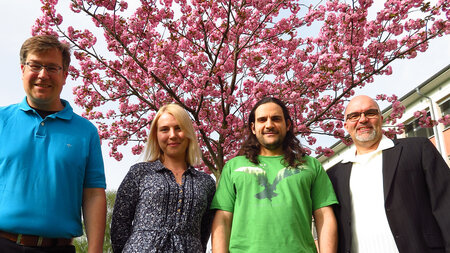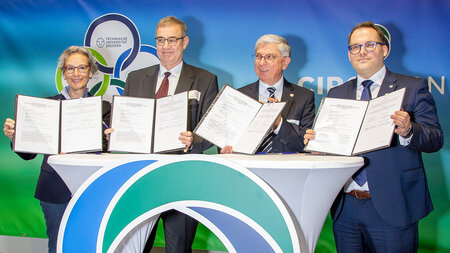In the Service of Science: Breaking New Ground in Virtual Worlds
Chemnitz University of Technology’s new Gait Analysis Laboratory enables fundamental and applied research within an interactive, real-time virtual reality environment – a TV report is available below
-
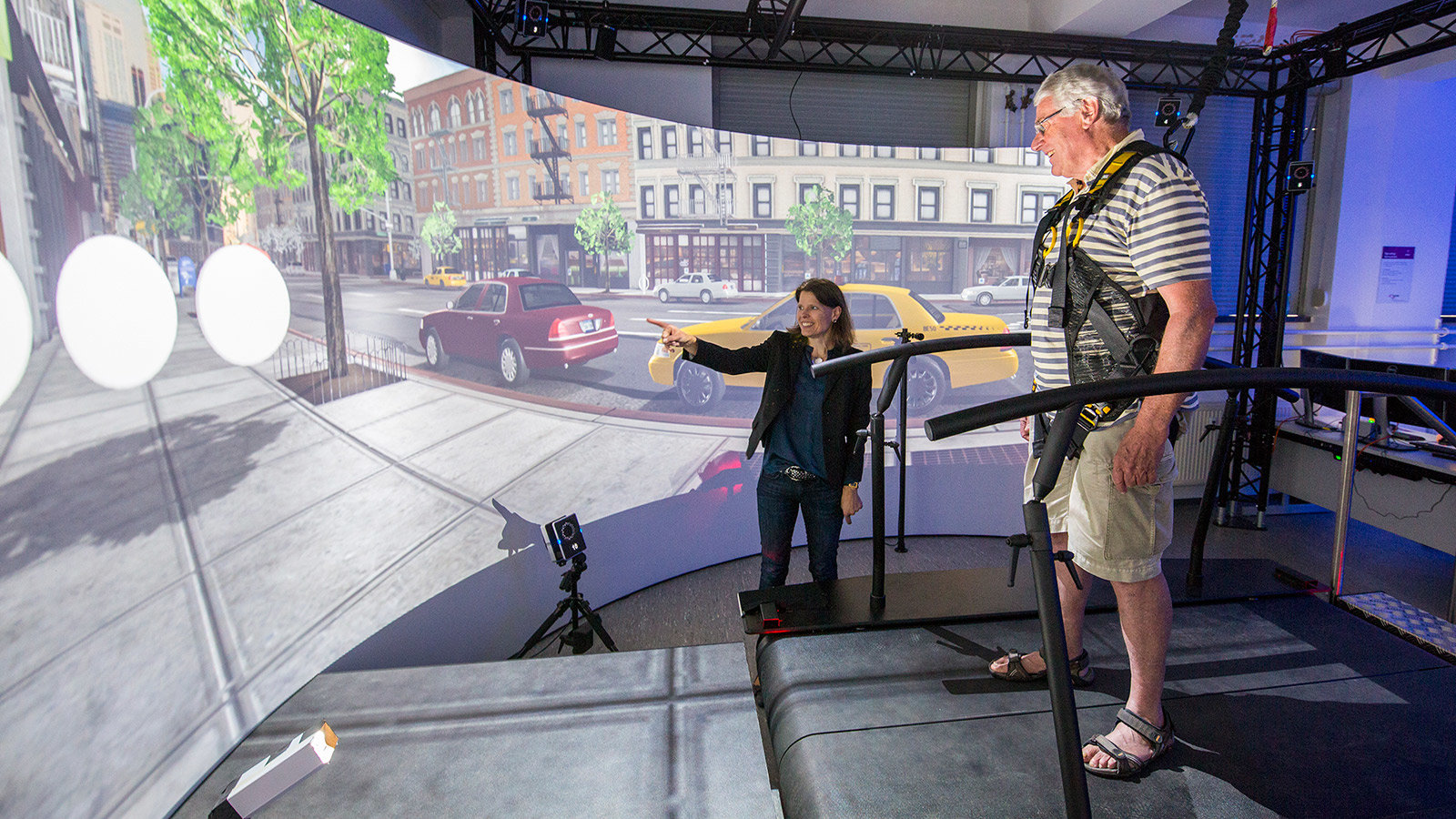
Prof. Dr. Claudia Voelcker-Rehage, Professor of Sports Psychology (with a focus on prevention and rehabilitation) at Chemnitz University of Technology, instructs a test subject in the gait analysis lab about cues that emerge during a walk in a virtual city. The virtual world is projected onto a 240 degree curved screen. In order to prevent the test subject from falling on the treadmill during the gait analysis, he is secured with a belt. Photo: Jacob Müller -
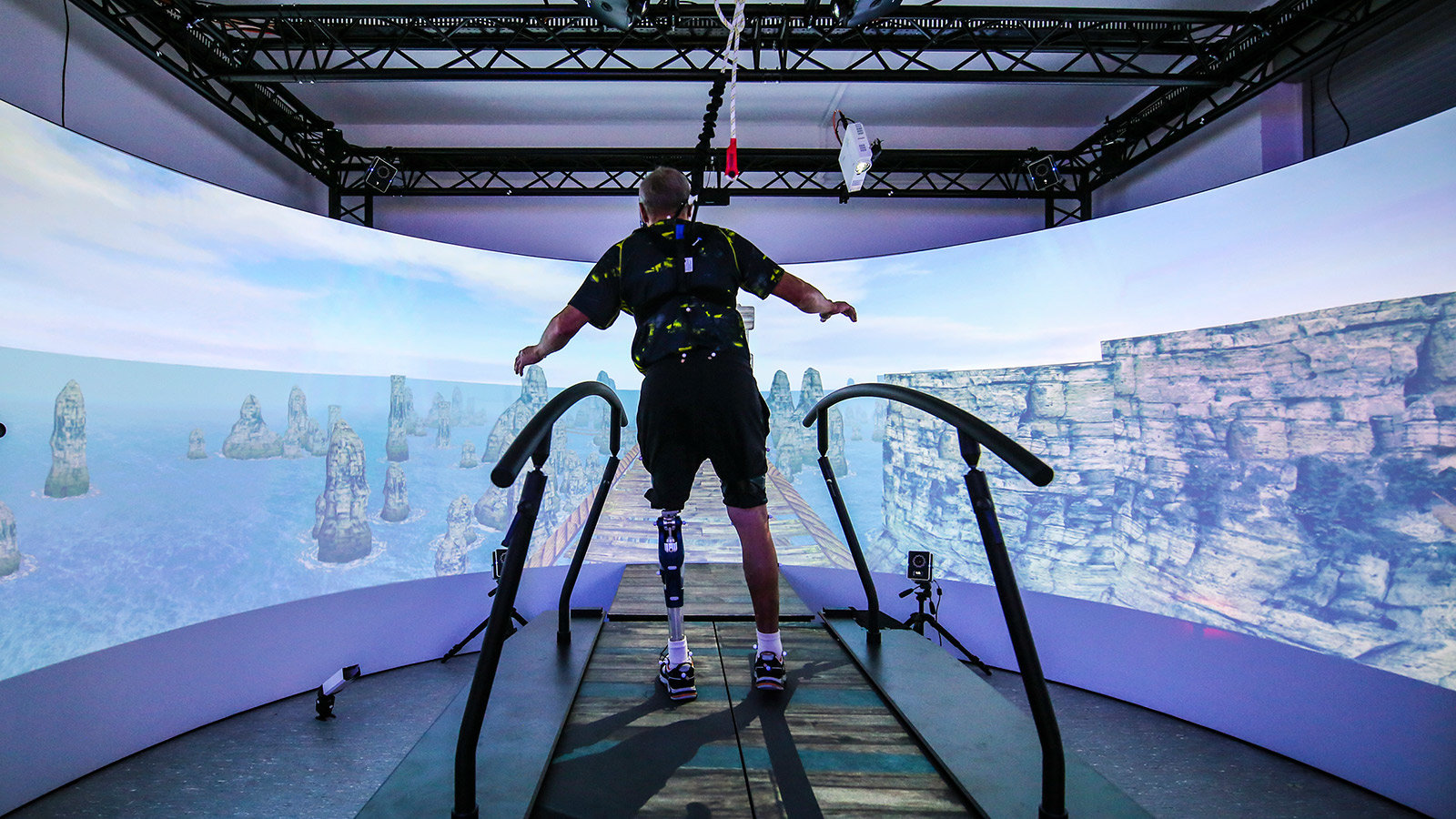
A test subject with a lower leg prosthesis is placed on a virtual suspension bridge. The typical sway of the bridge is simulated by a treadmill that moves on two axes. Securing the test subject with a harness and controlling the conditions during the gait analysis allows for a precise measurement of the test subjects’ movement within a realistic, yet safe, environment. Photo: Jacob Müller -
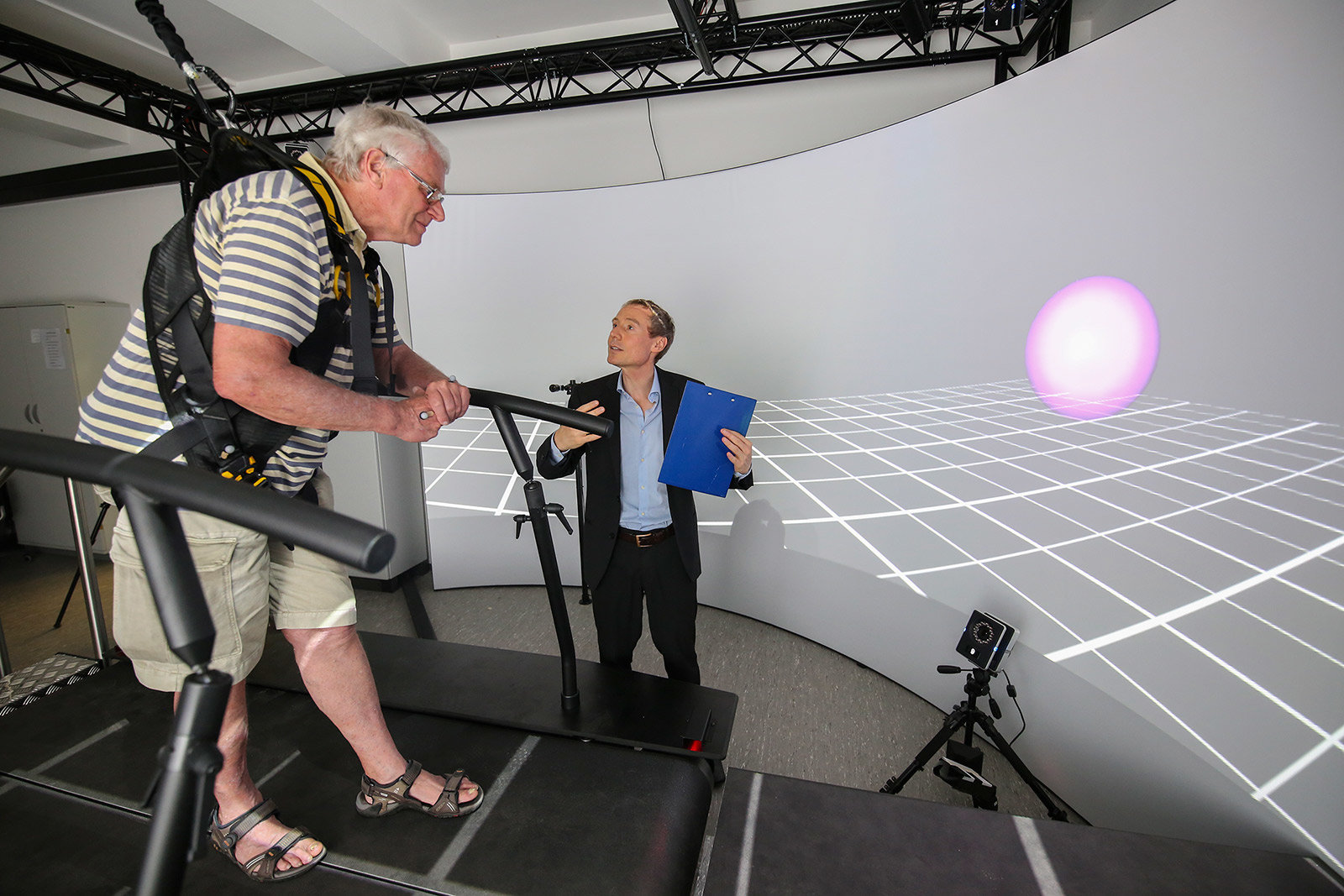
A test subject is examined in the Gait Analysis Lab by Prof. Dr. Georg Jahn, Professor of Applied Geropsychology at Chemnitz University of Technology. The test subject was instructed to complete a complex movement task, which also puts stress on the memory recall of the test subject. The test subject is protected with a belt. Photo: Jacob Müller -
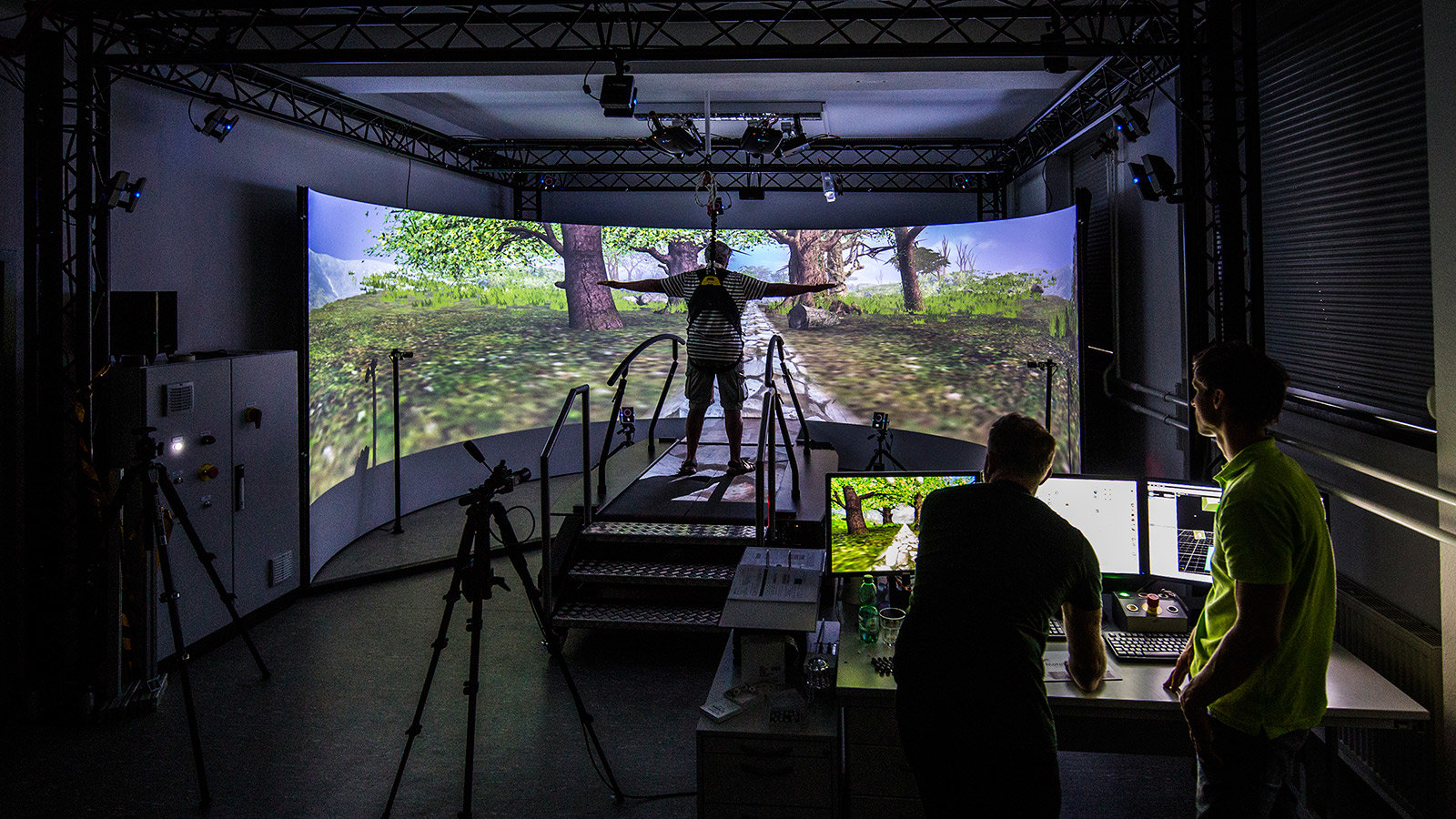
The complex system of the “Gait Real-time Analysis Interactive Lab” at Chemnitz University of Technology consists of a treadmill that can be hydraulically moved across two axes, and ten high-resolution motion cameras. The gait analysis system that is integrated into this virtual world is controlled via a control terminal. The test subjects are instructed by operators. Photo: Jacob Müller -
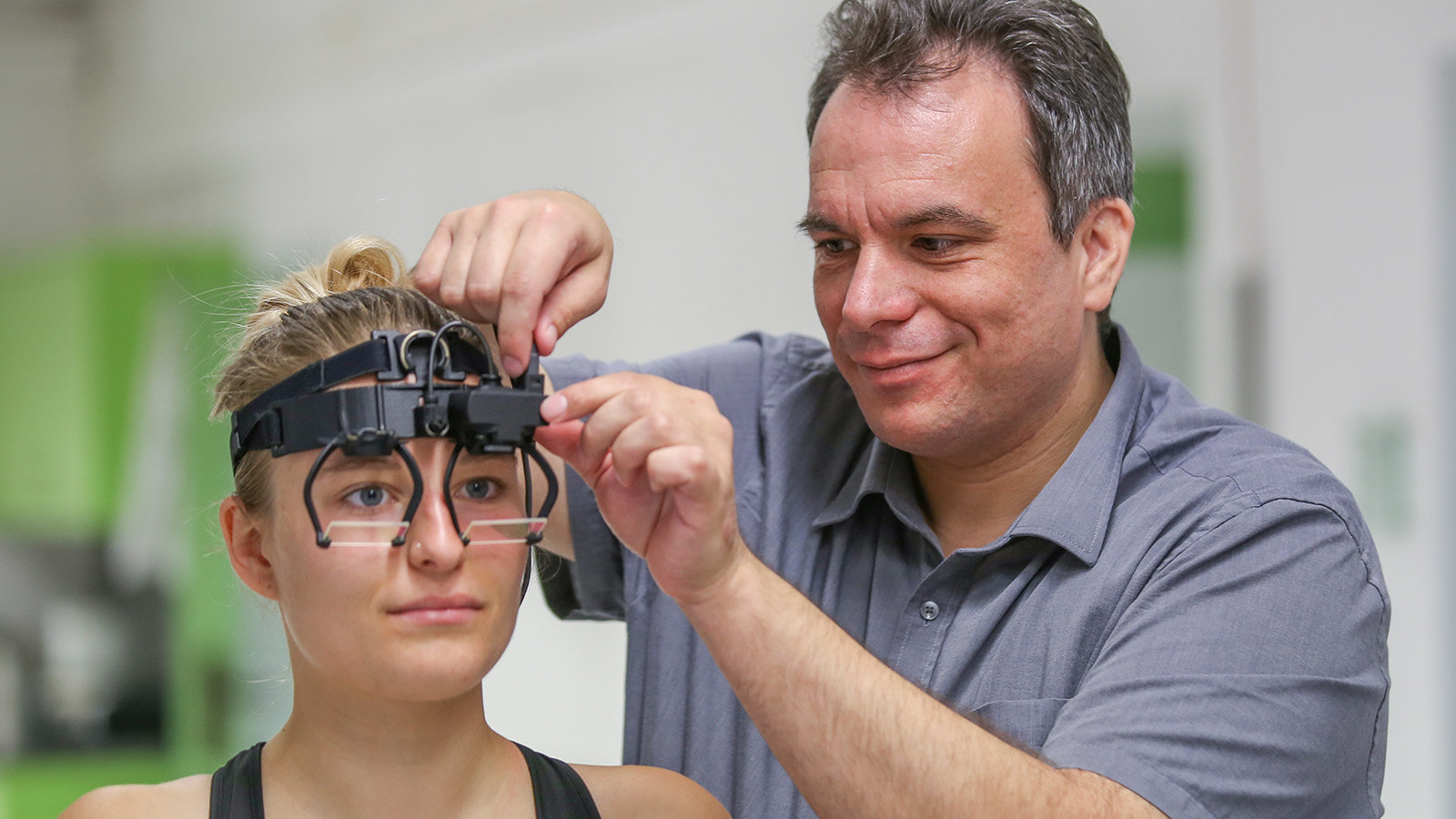
Prof. Dr. Wolfgang Einhäuser-Treyer, Professor of Physics of Cognition at Chemnitz University of Technology, prepares a subject for a test in the Gait Analysis Laboratory. He is adjusting an eye tracker to record eye movements during gait analysis. Photo: Jacob Müller -
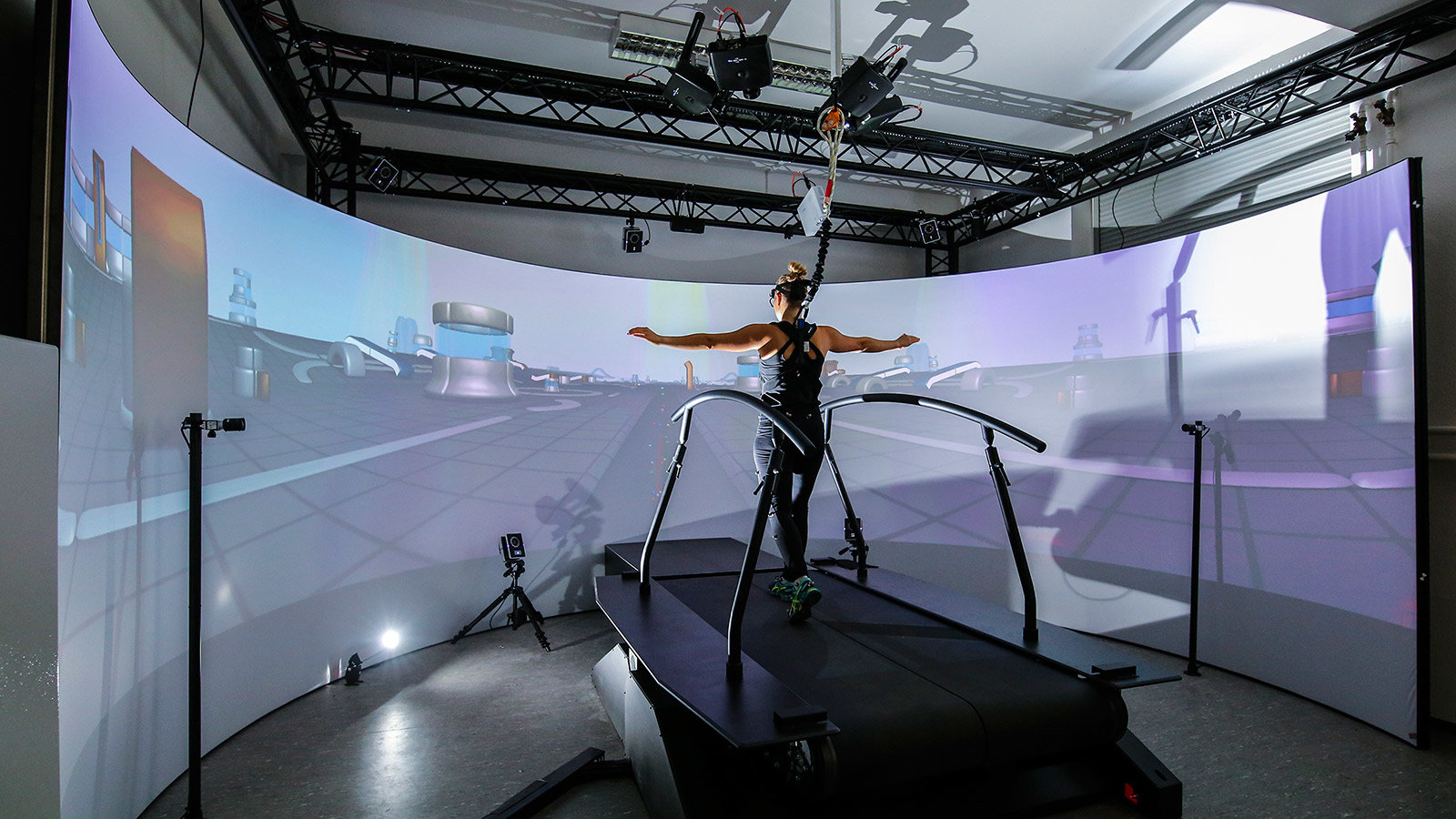
A test subject completes a complex movement task in the “Gait Real-time Analysis Interactive Lab” at Chemnitz University of Technology. In addition to gait analysis, eye movements are also analysed. Photo: Jacob Müller
The Faculty of Humanities and Social Sciences and the Faculty of Natural Sciences at Chemnitz University of Technology has acquired an interactive lab for real-time gait analysis, and it has now been put into operation. The so-called “Gait Real-time Analysis Interactive Lab” (GRAIL) is funded by the Free State of Saxony and the German Research Foundation (DFG), to the amount of roughly 650,000 Euros. “This large device is almost unique in Germany,” says Prof. Dr. Claudia Voelcker-Rehage, Chair of the Professorship of Sport Psychology (with a focus on prevention and rehabilitation). There is just one other comparable system, housed at the University of Rostock.
Six professorships get to the bottom of ‘walking’
The ability to control all variables related to walking and running in a real-time environment where they monitor exercise under realistic gait and environmental conditions is of particular benefit to researchers at Chemnitz University. Here, the main research areas of the participating professorships lie in different areas of motor skills, sensor technology, and cognition, with a specific focus on healthy ageing and patient groups. The GRAIL is currently being used by six professorships at Chemnitz University. In addition to the professorship of Voelcker-Rehage, it is used by the professorships of Human Locomotion (Prof. Dr. Thomas Milani), Research Methodology and Data Analysis in Biomechanics ( Dr. Christian Maiwald), Applied Geropsychology and Cognition (Prof. Dr. Georg Jahn), Cognitive Systems (Prof. Dr. Alexandra Bendixen), and Physics of Cognition (Prof. Dr. Wolfgang Einhäuser-Treyer). Nine trained and certified operators have already started the first test phase of the GRAIL system.
Motion analysis on virtual hills and suspension bridges
GRAIL provides a high-resolution, interactive lab environment for real-time full-body motion analysis in a variety of virtual realities (VR), allowing workgroups to perform their investigations under realistic, yet safe and standardized conditions, while increasing the number of available variables and their accurate measurement. “In the future, the role of healthy ageing, as well as a variety of symptoms, can be much better examined in the laboratory than in the past,” explains Voelcker-Rehage. Here, the subjects are placed on a hydraulic, dual-axis treadmill, and examined in a virtual world in which they perform different movement tasks, such as walking and running, as well as various balance tasks, sometimes at the same time, with various levels of difficulty. A 3-D motion analysis system and force sensors located under the treadmill allow for accurate and real-time recording of all of the test subjects’ movements, contrasted with three-dimensional biomechanical human models and task-specific changes in movement. The VR combines a 240 degree projected VR environment with a sound system – and it becomes noticeable, for example, as the treadmill begins to wobble as the subject walks over a projected suspension bridge. In addition, hills and curves of a virtual forest path can be simulated realistically. The treadmill speed automatically adapts to the gait speed of the test subject, and all tasks can be adjusted for the individual abilities of the subjects.
From gait training to preventing falls
What makes the new gait analysis lab so useful? “Investigations of stress during walking and running, for example, contribute to the prevention of injury among the elderly,” says Prof. Dr. Thomas Milani, Chair of the Department of Human Locomotion. For example, the gait can be specifically “disturbed” or the right and left leg may be controlled differently, which is particularly relevant for gait analysis, gait training, and fall prevention – for example, after a prosthetic restoration or during the process of rehabilitation. “People who suffer from balance and movement disorders, or people whose movements are restricted by a prosthetic leg may also be included in our studies,” adds Voelcker-Rehage. So that the test subjects do not fall during the gait analyses, they are secured with a belt.
Constantly changing conditions in traffic can also be simulated. Depending on the action, complex noises can even be generated, and these can influence how the subject walks or runs. One large advantage of GRAIL is that it can be combined with external measuring instruments. “In spite of the subject’s own movement, psychophysiological measuring methods such as eye-tracking, near-infrared spectroscopy, electroencephalography, and electromyography can be used, and thus data can be obtained under very realistic conditions,” adds Prof. Dr. Wolfgang Einhäuser-Treyer, Chair of the Professorship of Physics of Cognition. The measurement of movements in three-dimensional space is possible for the entire body, so that interactive tasks can be realised in freely programmable virtual environments, which can include arm movements such as pointing gestures while walking. According to Prof. Dr. Georg Jahn, these allow for the study of visual attention in moving scenes and of spatial memory during locomotion.
Research can prevent disease and positively influence the healing process
The interactive, real-time high-resolution properties of the GRAIL are on one hand of great benefit to foundational research at Chemnitz University, for example, in the field of motion analysis and the research of sensors, cognition, motor skills, and their relationships. On the other hand, the new university laboratory offers numerous approaches for application-oriented research in the field of prevention and healthy ageing, as well as neurorehabilitation; rehabilitation and prevention measures can be further developed here, and this can have long-term positive effects on illnesses and the cost of illnesses.
Multimedia: A television report is available on the opening of the gait analysis lab “GRAIL”. You can find it on the Chemnitz University YouTube channel: bit.ly/GRAIL_TUC
Further information is available via Prof. Dr. Claudia Voelcker-Rehage, Telephone +49 371 531-31889, E-mail claudia.voelcker-rehage@hsw.tu-chemnitz.de
(Author: Mario Steinebach, Translation: Jeffrey Karnitz)
Mario Steinebach
13.12.2018



